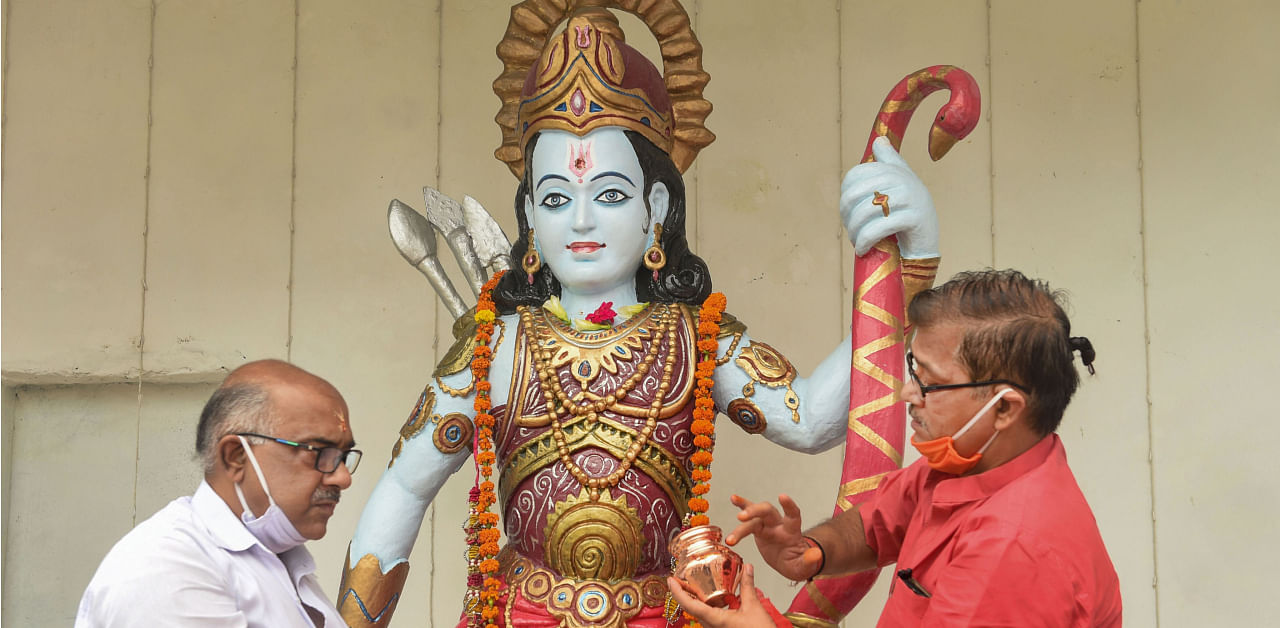
The Ayodhya Ram Mandir, managed by Shri Ram Janmabhoomi Teerth Kshetra trust, saw its foundation being laid on August 5 by Prime Minister Narendra Modi. The 2.77 acres of land that was contested for decades, now belong to Ram Lalla Virajman or the infant deity Ram.
Ram Lalla was one of the three contestants in the legal dispute. Read on to find out how exactly he acquired personhood.
The stakeholders in the matter -
Before the Supreme Court judgement on November 9, 2019, that settled the three-party dispute in the favour of Ram Lalla Virajman, the Ram Janmabhoomi title dispute was a complicated and long-drawn matter. There were three stakeholders at its crux - the Nirmohi Akhara, who are a group of Hindu devotees worshipping Lord Ram, Triloki Nath Pandey representative of Ram Lalla Virajman (the installed Infant Ram deity), and the Sunni Wakf Board.
While the Nirmohi Akhara and Sunni Wakf Board received extensive media coverage as stakeholders of the issue, there was always an air of mystery around who exactly Ram Lalla Virajman was, and how he was treated as a legal entity.
At one point, the Nirmohi Akhara even demanded complete control of the property and claimed it would not be satisfied, even if the land was attributed to Ram Lalla. They later withdrew this claim.
So how did Ram Lalla become a juristic entity?
The idea of a juristic entity is that of a body being recognised as a human being with the same rights. A body or company can be recognised as a juristic entity, meaning they would have the same rights as a person.
“Legal persons, being the arbitrary creations of the law, may be of as many kinds as the law pleases like corporate personality, body politic, charitable unions etc. Legal persons have rights and co-relative duties; they can sue and be sued, can possess and transfer property,” writes Pramod Kumar Kushwaha of the Uttarakhand Judicial and Legal Academy (UJALA).
In India, several entities, including deities, rivers like Ganga, and even corporations have been regarded as juristic entities. This means that Ram Lalla acquired personhood and could seek legal representation through a representative.
The history of the law -
According to the judgement on Shiromani Gurdwara Parbandhak Committee vs Som Nath Dass and Others (2000), which debated whether the Guru Granth Sahib is a juristic person or not - a juristic person, “is not an individual natural person but an artificially created person which is to be recognised to be in law as such”.
Like many Indian laws, the idea of juristic entity was also spawned from colonial law. In the British Era dispute, with Vidya Varuthi Tirtha v. Baluswami Ayyer, the wealth of the trust was conferred upon a shebait or manager of the Trust.
Is every deity a legal entity?
In the case of Yogendranath Naskar v. Commissioner of Income Tax (1969), it was established that not every legal entity receives personhood. In fact, only a deity installed in a public space for the people, can become a juristic entity.
The role of Sakhas -
It was with this legal history that Deoki Nandan Agarwal, a retired High Court judge, applied to become the sakha or ‘first-friend’ of Ram Lalla Virajman, the deity. Agarwal had been a devotee of Lord Ram and later a senior member of the Vishwa Hindu Parishad.
The titular dispute lasted so long that Ram lalla’s sakha changed several times.
Deoki Nandan Agarwal died on April 8, 2002. After his death, it was TP Verma, a professor of History, who was assigned as the next sakha to Ram Lalla. Post Verma’s ‘retirement’ from the position, Triloki Nath Pandey took the charge.
Ram Lalla has since been deemed as a perpetual minor, treated as a juristic entity represented by his sakha during this long-drawn legal battle.
On November 9, 2019, in a unanimous verdict, a five-judge Supreme Court bench granted 2.77 acres of the contested area to Ram Lalla. The land, which had been much disputed and contested over the last few decades, was later transferred to the infant deity himself.
On August 2, three days before the bhoomi pujan, the land was transferred to Ram Lalla Virajman itself, in the official records or nuzool of Ayodhya.
Therefore, the once-disputed territory now belongs to Ram Lalla Virajman, who can seek legal counsel through his sakha, Triloki Nath Pandey. The Shri Ram Janmabhoomi Teerth Kshetra trust would suprevise the construction and management of the Ram Mandir.